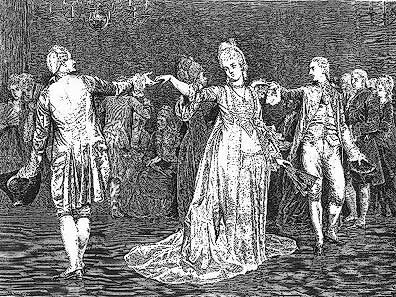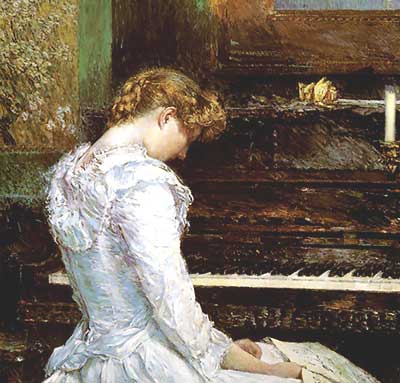|
THE CLASSICAL PERIOD
CONTINUED
| MINUET
AND TRIO FORM |
 |
|
 |
The
minuet and trio is usually found as the third
movement of a four movement Classical era
symphony, sonata, or string quartet and is the
only dance movement in these Classical era
works. It is in triple meter, of moderate
tempo and itís use was borrowed by Classical
era composers from Baroque period practice.
The first minuet was paired with a second
minuet called a trio. After the trio the first
minuet returns. So in actuality the form
should be called, Minuet Trio Minuet form. The
second big section is called a Trio because in
the Baroque era there were 3 instruments such
as 2 oboes or violins, 1 bassoon or cello,
plus continuo (harpsichord). During the
Classical era the Trio section had just fewer
instruments and if the Minuet was scored for a
string orchestra the Trio would be for the
woodwinds. After the Minuet and then the Trio
section are each repeated, the first Minuet
comes back without repeats. The internal
structure is diagrammed as follows:
| Minuet |
Trio
|
Minuet |
| I:A:I:BA: |
I:C:I:DC: |
I:ABA:I |
The Minuet was the most
popular social dance in Europe during the 1680ís
to 1690ís and remained popular after Louis the
XIVís death well into the Classical era.

| RONDO
FORM |
 |
|
 |
The classical form based
on the principle of periodic thematic return.
Typically rondo movements are light and
engaging and occur as the last movement in a
Classical sonata or Concerto. The meter is
usually duple and the tempo is usually presto.
The idea of departure and return is expanded
in the rondo and the internal structure can be
diagrammed:
A
B A C A D A
(coda)
The rondo theme
is catchy and remember able because you are
going to have to remember it when it comes back.
The thematic material of the contrasting
sections is usually filler music as to not
compete with the tuneful rondo theme. The form
goes like this: theme-something
different-theme-something different-theme
something different-theme and then inevitably a
coda to tell you there are no more contrasts.
Notice
how engaging and uplifting this rondo is from
Haydn's Symphony 88 in G, final movement
rondo. Also take note that the contrasting
sections have musical filler and do not
interfere with the tuneful rondo theme.
| SONATA
FORM |
 |
|
 |
The homophonic forms of
the classical period were created to
accommodate the possibilities of homophonic
texture. Remember that homophonic texture
allows for variation and contrast to a degree
not possible in polyphonic texture. The forms
of the classical era were meant to accommodate
the variational and contrasting possibilities
inherent in homophony. Of the classical forms;
theme and variations, minuet and trio and
rondo, sonata form (or sometimes called
sonata- allegro form) was the most important.
Most sonata forms are in moderately fast to
fast tempos. A slow tempo does not create the
kind of conflict and contrast that a sonata
form banks on, particularly in the development
section. So most sonata forms are fast in
order to create the sense of movement and
tension.
 |
 |
Childe
Hassam,
The Sonata, 1893.
|
The large scale sections
of sonata form are exposition,
development and recapitulation
(then usually a coda). It is in the exposition
that the themes are exposed. Similar to a
book, a play or a movie within the first five
minutes of the story a character or two is
introduced. Usually the first character you
meet is the most important character just
because they are the first character. What
ever relationships are revealed early are the
relations that will carry through. So it makes
sense the first section of a piece in sonata
form is going to be the point where the themes
are introduced. Typically the first
theme is the more dramatic of the
two, it galvanizes one's attention, it grabs
one's attention. The second theme
is typically the lyric theme. The greater the
contrast between theme one and theme two the
greater the potential drama, because the
greater the difference between the characters
the greater the need for resolution between
those differences and between the characters
the more dramatic the piece will be. So the
first theme is more dramatic then the lyric
theme second theme. These two themes are
separated by a segment of the movement called
a modulating bridge. The
word bridge means transition, the second theme
is typically more quite and then less pushy
then the first theme needs to be introduced
separately, the second theme would occur after
the more aggressive first theme it will sound
unimportant, it is supposed to sound like a
main theme. The way composers make the two
themes sound important is by putting a frame
around them. So that's what a bridge does, it
introduces a theme by leading up to it and
then often having an open cadence right before
the 2nd theme. The modulation during the
bridge of the exposition is one of the main
ways of creating contrast in sonata form. The
two themes in different keys during the
exposition and later in the same keys during
the recapitulation is a another way of
providing contrast albeit subliminal or
subtle. The listener doesn't necessarily
notice the harmonic contrast on a conscious
level, but does detect a different key. Sonata
form is two things at once. It is a way of
dealing with two themes and it is a way of
dealing with two harmonic areas. Because theme
one is in the tonic, theme two is somewhere
else and the tonic doesn't return again until
the beginning of the recap. Theme two
concludes with a section of music called a
cadence or cadential material. A general rule
of thumb you can say about the exposition is
that if the piece is in the minor key the
second theme modulates to the major. However
if the first theme is in major, the second
theme is in the key of the dominant or five
steps away. Modulating bridge and cadence
material are all based on the motives heard
before.
After the exposition
introduces all the themes it comes to a close
and the development section
starts. The development is built entirely on
previously heard material. The development is
also not characterized by any strong sense of
the tonic. The development is like an extended
modulating bridge. It will contain constant
momentum while something dramatic is done to
the two themes. The two themes are played with
clever techniques such as polyphonic
exploration, open cadences, fragmentation, re-
orchestration, modulation, sequences, dynamic
contrast and open cadence.
Finally the last big
section of a sonata form movement, the recapitulation
, brings back the the two themes (as they
occurred in the exposition) but this time both
themes are in the tonic key. These themes
(forceful and lyrical) return in the
recapitulation section just as they did in the
exposition section of a sonata form movement
but when they are revisited in the
recapitulation the listener experiences them
as both secure and stable because of the fact
that they both fall in the tonic key.
Here is the sonata-form
breakdown as it is found in movement IV of
Mozart's Symphony No. 40 in G minor, K. 550:
| EXPOSITION |
|
|
| Theme 1:
Dramatic theme, disjunct, contrasting
dynamics, minor key. |
|
|
| Modulating Bridge: Sequence,
motives, musical filler to provide
transition, forward momentum. |
|
|
| Theme 2: Lyric theme,
conjunct, major key. |
|
|
| Cadence Section: Closed
cadences, sequences, motives, closing
momentum. |
|
|
| DEVELOPMENT |
|
|
| Modulations: |
|
|
| Re-orchestration: |
|
|
| Polyphony: |
|
|
| Dynamics and open
cadences: |
|
|
| RECAPITULATION |
|
|
| Theme 1: Dramatic
theme, disjunct, contrasting dynamics,
minor key. |
|
|
| Bridge: Sequence,
motives, musical filler to provide
transition but this time non-
modulating, forward momentum.
|
| Theme 2: Lyric theme,
conjunct, minor key. |
|
|
| Cadence Section: Closed
cadences, sequences motives, closing
momentum. |
The
major difference in an exposition and a
recapitulation movement in sonata form is that
the second theme in the recapitulation is in
the tonic theme. In Mozart's Symphony No. 40
the overall key in G minor but in the
exposition the second theme is in the major
and then in the recapitulation the second
theme returns in the tonic key minor.
Listen to Theme 2 as
it appears in the exposition (new key, major):
Listen to Theme 2 as
it appears in the recapitulation (tonic key
minor):
Listen to the entire 4th
movement of Mozart's Symphony No. 40 in G
minor, K. 550.
In
Mozart's piano sonata in C, K54 the first
theme announced in the exposition is already
gentle but Mozart is able to further the
lyricism in the expositions second theme.
|




